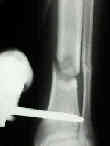- Considerations:
- consider applying an arthroscopy post to the table inorder to assist w/ reduction;
- w/ the post in place, 3 point pressure can be applied;
- fracture should be reduced as much as possible prior to application of external fixator;
- if the fracture is open or if a fasciotomy has been performed, the surgeon can use the open wounds to help reduce the fracture;
- bone clamps can be applied to hold the reduction;
- closed fracture:
- temporary half pins can be applied to close to the fracture (on one or both sides) and then used to "joy stick" the reduction;
- the half pins can be appied on the anterolateral side, so as not to interfere with the medially placed fixator;
- applying a "T" chuck handle may asssist w/ the reduction;
- alternatively apply a pelvic reconstruction tenaclum clamp percutaneously across the fracture inorder to achieve a reduction;
- if these measure fail consider opening the fracture in order to achieve reduction, noting that a poorly reduced fracture may have the worst prognosis for healing;
- associated fibular fracture:
- plating of the fibula via a separate incision may increase overall rigidity while avoiding problems of lag screw fixation into open tibial wounds;
- once healed, intact fibula can also facilitate later posterolateral bone grafting of tibia if union is delayed;
- Case Example:
- 30-year-old prisoner who sustained a patellar fracture and a distal tibia fracture;
- he was treated w/ an external fixator but several treatment principles were ignored;
- the fracture was left distracted, the pins were not spread out and were placed well away from the fracture site, and the fixator bar was not near the skin;
- as might be expected, this went on to a non union




